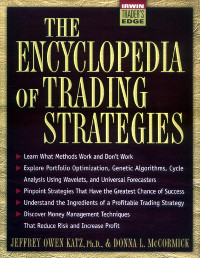

As its name suggests, Encyclopedia of Trading Strategies contains descriptions of many trading strategies. But, for an encyclopedia, it is structured quite unconventionally and, also, its purpose is different from that of a normal encyclopedia.
Contents
- 1 Structure
- 2 Purpose
- 3 The Authors
- 4 Why I Recommend This Book
- 5 What You Will Not Find in This Book
Structure
The book is divided into three big parts — introduction, entries and exits. The book starts off with rather extensive but outdated information on testing data, testing simulators, optimization software and statistics used in trading strategies’ analysis.
The second part is the biggest one and consists of several chapters, which group together several trading strategies that share some common idea, like seasonality or breakouts. Each chapter presents a reader with a broad description of the trading methods, the source code of the C++ program that was used to test the methods, and the
The third part is a study of exits, which is very similar to the part on entries, except that much fewer strategies are tested.
Purpose
The purpose of the book is not to give a reader a selection of trading strategies where he would pick the best one and then would trade it for huge profits. No, the authors do not even list such strategy in the book. The purpose is to show the following:
The Authors
Together, Jeffrey Owen Katz and Donna McCormick authored many articles on trading strategies and their tests since early 90’s. You might know them if you read Technical Analysis of Stocks and Commodities or Virtual Trading magazines back then. Basically, this book is a more
Apart from being a financial trader, Jeffrey Katz is also an observatory director at Custer Institute, while Donna is an observatory president there. This might explain some of the nontraditional trading ideas tested in the The Encyclopedia of Trading Strategies.
Why I Recommend This Book
Despite the disadvantages of this book that are evident from its age (published in 2000) and abundant online reviews, I would like to point out the following advantages that in, my opinion, outweigh all the bad about The Encyclopedia of Trading Strategies:
What You Will Not Find in This Book
Perhaps, you have your own expectations from this book, but I would like to present the following list of the things you will not find in the book, to not let it disappoint you:
It would be great to find a similar book but with a more recent test data and with a focus on Forex. The transaction costs and slippage used in The Encyclopedia of Trading Strategies have little to do with the actual situation in currencies. Until then, I would recommend the work by Katz and McCormick to both new and experienced FX traders.
If you have any questions, comments or opinions regarding The Encyclopedia of Trading Strategies by Jeffrey Katz and Donna McCormick, please feel free to post them using the commentary form below.